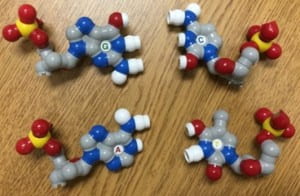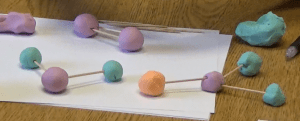Overview
The overarching goal of our research group is to determine how we can make chemistry more accessible for all students. All of the current projects seek to answer: 1) How do we improve student understanding of chemistry? and 2) How do we assess student understanding?
Predicting Student Success in General Chemistry and Organic Chemistry Courses
Undergraduates who have worked on the project: Alexandra (Lexi) Brooks, Katherine Raschmann, Lisa Vu, Han (Kailey) To, Joy Trautwein, Kara Duncan, Aaron Kramer, Elizabeth C., Maria Bontrager, Isaac Blythe
The growing Hispanic population across the United States suggests we may need to find different indicators to help identify students prone to repeating or dropping courses. In the state of Texas, while 51.7% of incoming 2007 freshmen class graduated within 6 years at public 4-year institutions, only 43.5% of Hispanic students were successful (Ref). General chemistry and organic chemistry are often considered barrier courses with large portions of students failing each course. This study is focusing on several factors including student content knowledge using the ACS Anchoring Concepts Content Maps for General Chemistry and Organic Chemistry, student participation in Supplemental Instruction programs, student attitudes, study habits, and demographics. Historical data that was collected as part of curriculum assessment, as well as data collected over the next two years, will provide both a cross-sectional look as well as a longitudinal look at student retention through their first two years of chemistry courses.
This study is focused on answering three specific research questions: 1) How does students’ understanding of general chemistry content knowledge of core concepts affect their ability to succeed in future chemistry courses? 2) What percentage of students taking general chemistry with the intention of pursuing a STEM career pass organic chemistry without retaking classes? 3) What are the key factors in students needing to retake general chemistry courses and organic chemistry courses in order to advance in their degree program?
Accessing General Chemistry and Biochemistry Students Understanding of Intermolecular Forces Between Small Structures and Within Large Structures
Undergraduates who have worked on the project: Magdalena (Maggie) Barnes, Mitra Rahimi, Jenna Adams, Calisa Moron, Damien Goodwin, Daisy Secundino, Katie Shaw, Destin Huynh, and Patrick Delgado
One way to improve the accessibility of chemistry, is to find ways to measure how well people understand the fundamental underlying chemistry concepts. Across the Chemistry Education Research community, researchers have been building concept inventories that are designed to measure students’ conceptual understanding. While these tools are being developed, it is still unclear how, and if, the tools are being used in chemistry classrooms. In addition to the growing misconceptions literature, the ACS recently focused on the content coverage of ACS exams over the past 20 years in general chemistry (Luxford & Holmes, 2015). It was found that while general chemistry is a course sequence that services biology and health-related majors, there is a lack of emphasis on the intermolecular forces within large molecules. Students in second-semester general chemistry and students in biochemistry were invited to participate in a 30 minute semi-structured interview which explored students level of understanding of intermolecular forces using representations of small structures as well as a portion of the protein folding of hemoglobin.
This study is focused on answering the following research questions: 1) What does student explanations of intermolecular forces reveal about their understanding of attractive forces within large protein structures? 2) Are general chemistry students able to make the leap from intermolecular forces between small structures to apply their understanding to larger structures? 3) How are the explanations of general chemistry and biochemistry students similar and different from one another?

